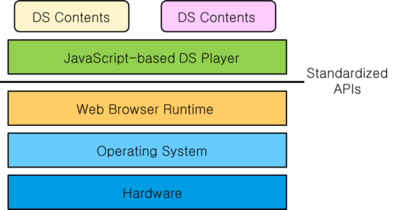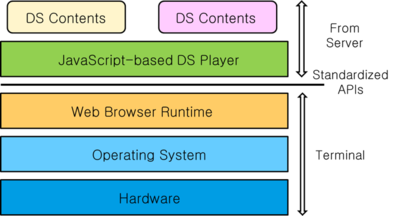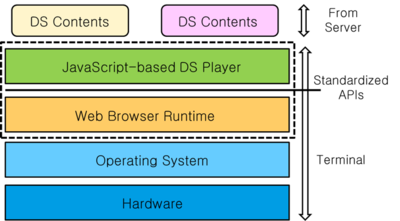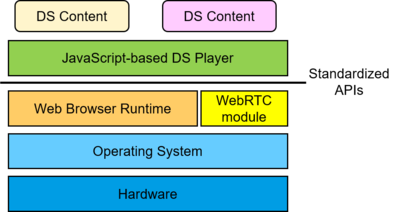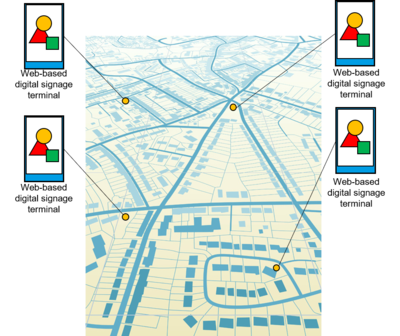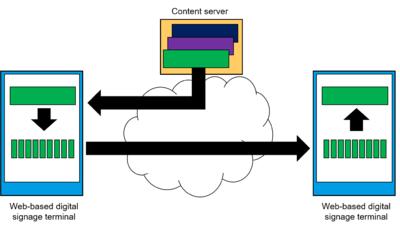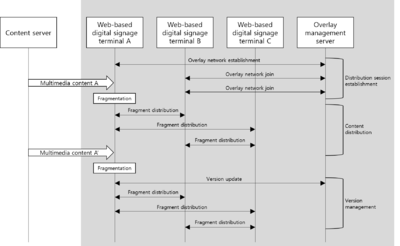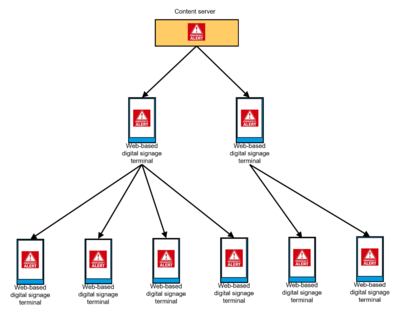Warning:
This wiki has been archived and is now read-only.
Architecture of Web-based Signage
Architecture of web based digital signage in terminal device
Editor’s Draft (23 November 2016)
- Editor
- Shin-Gak Kang, ETRI
- Futomi Hatano, Newphoria Corporation
- Kiyoshi Tanaka, NTT
Copyright © 2012 W3C® (MIT, ERCIM, Keio), published by the Web-based Signage Business Group under the W3C Community Contributor License Agreement (CLA). A human-readable summary is available.
Contents
- 1 Abstract
- 2 Status of this document
- 3 Conformance
- 4 Introduction
- 5 Scope and terminology
- 6 Architecture of Web-based Digital Signage
- 7 Mapping with Digital Signage Functional Architecture (H.781)
- 8 Requirements for Interaction among Web-based Digital Signage Terminals
- 9 Operations for Interaction among Web-based Digital Signage Terminals
- 10 Consideration on Low-Delay Distribution of Important Content
- 11 References
Abstract
This document describes architecture of web-based digital signage services in the terminal device. The various implementation models based on general web signage architecture are described. Also, the mapping with functions of digital signage defined in “Recommendation ITU-T H.781, Digital Signage – Functional Architecture”.
Status of this document
This document is in drafting stage and developed based on discussion results at the face-to-face meeting of Web-based Signage Business Group in 22-23 November 2016, Seoul, Korea.
Conformance
As well as sections marked as non-normative, all authoring guidelines, diagrams, examples, and notes in this specification are non-normative. Everything else in this specification is normative. The key words "MUST", "MUST NOT", "REQUIRED", "SHALL", "SHALL NOT", "SHOULD", "SHOULD NOT", "RECOMMENDED", "MAY", and "OPTIONAL" in the normative parts of this document are to be interpreted as described in RFC2119. For readability, these words do not appear in all uppercase letters in this document. [RFC2119]
Introduction
This document describes architecture of web-based digital signage services in the terminal device. The various implementation models based on general web signage architecture are described. Also, the mapping with functions of digital signage defined in “Recommendation ITU-T H.781, Digital Signage – Functional Architecture”. Especially, functions defined in ITU-T H.781 should be taken into account to implement digital signage client on the web browser. The mapping relationship between web signage architecture and functional architecture of ITU-T will help people to understand how to realize web-based signage services and applications.
Scope and terminology
- DS Contents mean everything shown on a digital signage display. The contents of web-based signage are served by a content server through a network. They consist of HTML, CSS, and JavaScript. Some contents are possibly created using XML-based technologies which are embedded in HTML, such as SVG (Scalable Vector Graphics).
- A player plays contents for web-based signage. It is a set of an application and a runtime. This document is not aimed for limitation of underlying hardware and the operating system. Basically, web-based signage is based on the core profile (this document). As necessary, web-based signage systems adopt the other profiles additionally.
- A runtime is a common web browser (e.g. webkit-based browsers, Firefox, IE, etc.) or a web-based application runtime (e.g. Firefox OS, Tizen, Windows 8, etc.) installed in tablets, PCs, STBs, TV (most of current high-end TV products implement a web-browser), etc. On the other hand, it is not a dedicated subset or subset-based derivation of HTML5 in wide sense. Basically, runtime offers functions called HTML5 in the wide sense. Basically, the specifications of HTML5 in wide sense are be specified particularly by W3C.
- Terminal device typically presents and/or processes the content, such as a personal computer, a computer peripheral, a network appliance, a mobile device, a TV set, a monitor, a VoIP Terminal or an audio-visual media player. In this document, terminal device means a set-top box to present digital signage contents.
- Web-based signage is digital signage whose contents are created using web-technologies. Besides, it has a capability of connecting to a network. It is not a matter whether the network is the Internet or not. The web-based signage includes the terminal in an intranet.
- ""WebRTC"" is client-side APIs to enable Real-Time Communications in Web browsers developped by Web Real-Time Communications Working Group.
- ""P2P (Peer-to-peer)"" is a computer networking architecture in which all participating nodes (peers) have equal privileges and share the workload.
Architecture of Web-based Digital Signage
There are several ways to implement digital signage services and applications on the web environment. General architecture for web-based digital signage is described in Figure 1. Digital Signage (DS) contents include HTML content and multimedia contents which consist of graphics, image, video, audio, sound, etc. DS player is a java script based web applications for playing digital signage contents. Web browser runtime includes Gecko, Edge HTML, WebKit, Blink, etc. Operating Systems can be Linux, Windows, Android, Firefox OS, etc.
Based on the general architecture of web-based digital signage terminal, there are several ways to implement digital signage services and applications on the web environment. The Figure 2 and Figure 3 show some example architectures of web-based digital signage in terminal device.
Figure 2 presents an implementation model where digital signage applications (e.g. DS player) and contents are provided by DS web server and executed on the web browser runtime of terminal device.
Figure 3 presents an implementation model where digital signage applications (e.g. DS player) and web browser runtime are embedded in DS terminal device. In this case, DS contents are provided by DS web server and executed on the Java Script-based DS player of terminal device.
In aforementioned architecture, a web-based digital signage terminal is assumed to display the multimedia content sent by a content server in realtime. As a different scenario, the web-based signage terminal can receive multimedia content B during it displays multimedia content A. On the basis of specific event, for example specific time or command from server, the web-based signage terminal display multimedia content B. To support the scenario, architecture of web-based digital signage terminal needs to be extended to contain additional communication module. Figure 4 is the extended version of the architecture depicted in Figure 1. Modern web browsers support WebRTC so the extension can be easily implemented.
Mapping with Digital Signage Functional Architecture (H.781)
This clause describes the mapping relationship between web-based digital signage architecture and functional architecture of digital signage defined by ITU-T as Recommendation H.781 [H.781]. ITU-T SG16 is also working on guidelines about web-based digital signage in Rapporteur Group Q14 (Digital signage systems and services). [DS-WDS] Basically, each function defined in ITU-T H.781 for providing digital signage services would be implemented as part of Java Script based digital signage player. The detail mapping relationship will be defined further. [TBD]
Requirements for Interaction among Web-based Digital Signage Terminals
This clause describes the requirements for interaction among interoperable web-based digital signage terminals conformed to the architecture depicted in Figure 4. Conforming the architecture of web-based digital signage terminal indicates that the web-based digital signage terminal is required to conduct operations including synchronizing, caching, and sharing the multimedia content to be displayed. Synchronization means displaying the same multimedia content on the web-based digital signage terminals which are configured to be synchronized. For example, web-based digital signage terminals need to display a certain multimedia content on a specific time, if the content is supposed to be shown on the specific time. Displaying a certain multimedia content on a specific event can be another example of synchronization. Figure 5 shows an example of web-based digital signage terminals displaying the same content. To support the time synchronization, web-based signage terminals are required to be time-synchronized based on a specific wall-clock. In addition, web-based signage terminals are also required to be capable of exchanging data with each other to support event-driven synchronization.
Caching and sharing the multimedia content means the content is temporally stored on a web-based digital signage terminal and it can be shared among web-based digital signage terminals. To efficient sharing the content, web-based digital signage terminals are required to be capable of splitting the content into multiple pieces and also assembling the pieces. In addition, each web-based digital signage terminal is required to be capable of generating and sharing the information of pieces which it has. On the basis of the information, for example, web-based digital signage terminal A can request specific pieces to other web-based digital signage terminals which have the pieces. Figure 6 depicts the concept of caching and sharing multimedia content between web-based digital signage terminals.
Modern web browsers support [WebRTC]. By using [WebRTC], web-based digital signage terminals can exchange data with each other. The communication among web-based digital signage terminal can alleviate the delivery burden on a content server. In addition, the direct communication among web-based digital signage terminals also enables the delivery of multimedia content when the content server is failed if any web-based digital signage terminal has the multimedia content to be distributed. Moreover, a web-based digital signage terminal can simultaneously get one or more multimedia content from multiple web-based digital signage terminals by supporting [WebRTC]. In addition to supporting [WebRTC] web-based digital signage terminals need a signaling protocol for connection management and data exchange. [X.609.7] developed by ITU-T SG11 provides a signaling protocol for content distribution over P2P network organized by the direct communication of terminal nodes.
Operations for Interaction among Web-based Digital Signage Terminals
The interaction among web-based digital signage terminals means the direct communication among the web-based digital signage terminals for sharing multimedia content. Content server is not involved in the direct communication. Thus, the web-based digital signage terminals need to conduct several operations such as connection management. This clause describes the operations of the direct communication. Note that this document does not cover the detailed operations, because the detailed operations depend on the signaling protocol such as [X.609.7]. Figure 7 shows high-level procedures for the direct communication among web-based digital signage terminals.
To share multimedia content, web-based digital signage terminals need to organize an overlay network which is a logical network. On the overlay network web-based digital signage terminals can interact with each other without intervention of content server; content server needs to inject multimedia content to one of web-based digital signage terminals before the interaction among web-based digital signage terminals. To organize an overlay network, web-based digital signage terminals need to interact with a server managing overlay network, overlay management server in Figure 7. The overlay management server can be divided into multiple servers based on roles, but it is not under scope of this document. Firstly, a web-based digital signage terminal, web-based digital signage terminal A in Figure 7, requests the server to establish an overlay network. Then rest web-based digital signage terminals can request the server to join the overlay network. The rest web-based digital signage terminals can join the overlay network without any request, if the overlay network is configured to contain them when it is established; this operation depends on the signaling protocol. After establishment, web-based digital signage terminals can interact with each other. When one of web-based digital signage terminals receives multimedia content sent by content server, it splits the content into multiple fragment. The way to distribute the fragments depends on the signaling protocol to be used. In push-based distribution, the web-based digital signage terminal conducted fragmentation sends fragments to some of web-based digital signage terminals. Then the web-based digital signage terminals received the fragments relay the received fragments to other web-based digital signage terminals. In pull-based distribution, web-based digital signage terminals requests possession status information to other web-based digital signage terminals. When a web-based digital signage terminal finds any web-based digital signage terminal with new fragment, it requests the terminal to send the new fragment. Content server can offer new version of multimedia content. Correction of any problem in the previously published multimedia content can be an example. In such case, the web-based digital signage terminal received the new version of multimedia content notifies overlay management server of the revision. Notification to rest web-based digital signage terminals depends on the signaling protocol. After the notification, rest web-based digital signage terminals interact with the web-based digital signage terminal with the new version of multimedia content.
Consideration on Low-Delay Distribution of Important Content
In a certain scenario, web-based digital signage terminals need to display an important content such as disaster alert. Since such important content needs to be displayed as soon as possible, it is required to consider the support of low delay distribution in the interaction among web-based digital signage terminals. It was introduced that an overlay network is organized for direct communications among web-based digital signage terminals. The topology of the overlay network is important in the performance of distribution, especially the delay. Mesh topology supports pull-based distribution which needs four steps; request for possession status information, respond for the status request, request for specific fragment(s), and respond with the requested fragment(s). Tree topology supports push-based distribution which needs one step; sending new fragment(s) to child node(s). Thus, mesh topology introduces more delay than tree topology. The high dynamics of P2P networking affects the stability of overlay network in tree topology. However, web-based digital signage terminals join stably until the end of service. Consequently, for distribution of important content, support of tree topology needs to be considered for the interaction of web-based digital signage terminals. Supporting both topologies can be another approach. Organizing an overlay network in mesh topology for a stable distribution of content. Then one or more overlay network in tree topology for rapid distribution of content. [Q.4100] introduces the functional architecture of hybrid P2P communications..
References
[H.781] Recommendation ITU-T H.781 (2015), Digital Signage: Functional Architecture
[X.609.7] Recommendation ITU-T X.609.7 (2018), Managed P2P communications: Content distribution peer protocol
[Q.4100] Recommendation ITU-T Q.4100 (2020), Hybrid P2P communications: Functional architecture
[DS-WDS] Draft Technical Paper ITU-T HSTP.DS-WDS, Digital signage: Web-based digital signage
[WebRTC] WebRTC 1.0: Real-Time Communication Between Browsers
